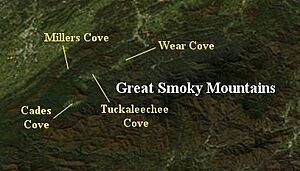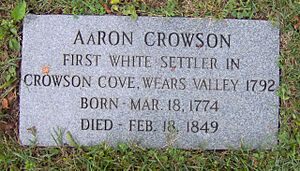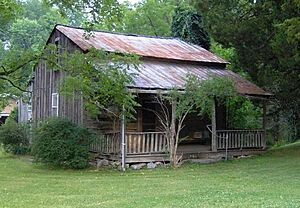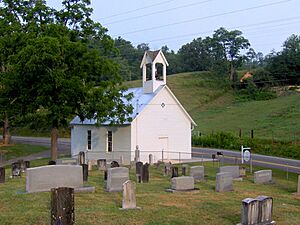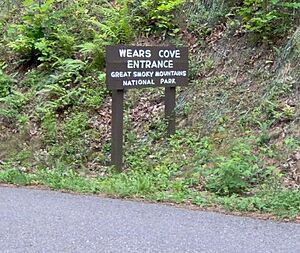Wear Cove facts for kids
Wear Cove is a beautiful valley located in the southwestern part of Sevier County, Tennessee. It stretches alongside the famous Great Smoky Mountains National Park to its south. Just like other areas near the park, Wear Cove's history and economy are closely connected to the Smokies. The main community here is called Wears Valley.
Wear Cove is a special kind of valley known as a "limestone window". This happens when erosion wears away older Precambrian sandstone, revealing younger Paleozoic limestone underneath. The northern edge of the Smokies has many limestone coves, like the well-known Cades Cove and Tuckaleechee Cove. Limestone coves have very rich soil, which attracted early settlers to the area.
The valley is surrounded by mountains: Cove Mountain to the southeast, Roundtop to the southwest, Davis Mountain to the northwest, and Hatcher Mountain to the northeast. Many smaller valleys, called hollows, cut into these ridges. Some of these include Happy Hollow, Smith Hollow, and Little Cove.
U.S. Route 321 is the main road through Wear Cove. It connects Townsend in the west to Pigeon Forge in the east, where it joins U.S. Route 441. This part of Route 321 is often called "Wears Valley Road." Another road, Lyon Springs Road, links Wears Valley Road to Little River Road inside the national park. It crosses a gap between Cove Mountain and Roundtop, leading to the Metcalf Bottoms campground.
Contents
History of Wear Cove
Who Were the First Settlers?
Wear Cove gets its name from Samuel Wear, a hero of the American Revolutionary War. He built a fort near the valley's entrance, in what is now Pigeon Forge. The valley was first called "Crowson Cove," named after its very first settler, Aaron Crowson (1774–1849). We don't know exactly why the name changed, but by 1900, it was known as Wear Cove.
Aaron Crowson arrived in Wear Cove from North Carolina in 1792 with his friend, Peter Percefield. This was a time when there was a lot of tension between the Cherokee people and the new European-American settlers moving into their lands. Wear's Fort was attacked in 1793. Samuel Wear then led a group to attack the Cherokee village of Tallassee. In May 1794, Peter Percefield was killed in a Cherokee attack. Crowson rode to Wear's Fort for help, but the Cherokee had left by the time he returned. Percefield was buried on a hill in the eastern part of Wear Cove, which is now Crowson Cemetery. Later that year, Crowson received a land grant for this area.
Other early settlers in the cove included William Headrick, a Revolutionary War veteran who arrived in 1821. John Ogle, a veteran of the War of 1812 and son of the first settlers in Gatlinburg, also settled here. Another War of 1812 veteran, Peter Brickey (1769–1856), came in 1808. Brickey ran a large farm and a place to make drinks in the valley until he passed away in 1856. The log home he built around 1808 is still standing in Smith Hollow (between Wears Valley and Townsend) and is a recognized historic place.
Like many other farms in the cove, the Brickey farm was greatly affected by the American Civil War. In 1864, Isaac Trotter, who worked at the iron forge in Pigeon Forge, reported a Cherokee raid in Wear Cove. Earlier in the war, a Union army marched through the valley. They were on their way to remove the troops of Will Thomas, who were set up in Gatlinburg.
After the war, Alfred Line started a farm at the base of Roundtop Mountain, in the southern part of Wear Cove. A clear mountain spring, Line Spring, flows from Roundtop's slopes. This spring gave its name to a small recreation area that grew in this part of the cove. In the late 1800s, people believed that mineral-rich mountain springs could improve health. This led to early tourism in mountain areas. In 1910, D.B. Lawson, whose father had bought the Line farm, built the Line Spring Hotel. The hotel helped the valley's economy by creating a market for local farmers' goods.
Churches and Community Life
Around 1800, Aaron Crowson and other settlers built a simple log church called Bethlehem Church. Both Methodists and Baptists used this church throughout the 1800s. Baptists had services led by an elected pastor, while Methodists had services led by traveling preachers called circuit riders. Sometimes, both groups would meet together for a special "union meeting," like a small revival. In 1886, both Baptists and Methodists built their own separate churches, but they still often held union meetings.
For most of the 1800s, funerals in the valley were held at Headrick Cemetery, near the western entrance of the valley. A large oak tree provided shade for people attending funerals. However, cold weather and rain often showed the need for a building to hold indoor services. In 1902, local stories say that lightning struck and destroyed the oak tree. In response, the people built Headrick Chapel on the cemetery grounds. Four Baptist and Methodist churches shared the chapel, and funeral services always had priority. The chapel's bell would ring once for every year of the person's life who had passed away. This tradition is still followed by the people of Wears Valley today. In 2001, Headrick Chapel was added to the National Register of Historic Places, recognizing its historical importance.
Wear Cove and the National Park
In 1934, the Great Smoky Mountains National Park was created. The park's boundary runs along Wear Cove to the south, following the tops of Roundtop and Cove Mountain. After improvements were made to US-321 in the 1950s, tourist businesses slowly started to appear in the cove. Today, you can find many cabin rentals and outdoor supply stores in the valley that cater to tourists.
In 2005, a group of developers planned to build 400 houses on the slopes of Cove Mountain. Many valley residents were worried about how this development might affect the beautiful views of Cove Mountain. In 2007, a group called "Friends of Wears Valley" opposed the development. They tried to stop the housing expansion on Cove Mountain by asking the Sevier County Regional Planning Commission for help, but they were not successful. The group has put up "Save Our Mountains" signs throughout the valley. However, the developers say their plans will not harm the mountain's natural beauty.


